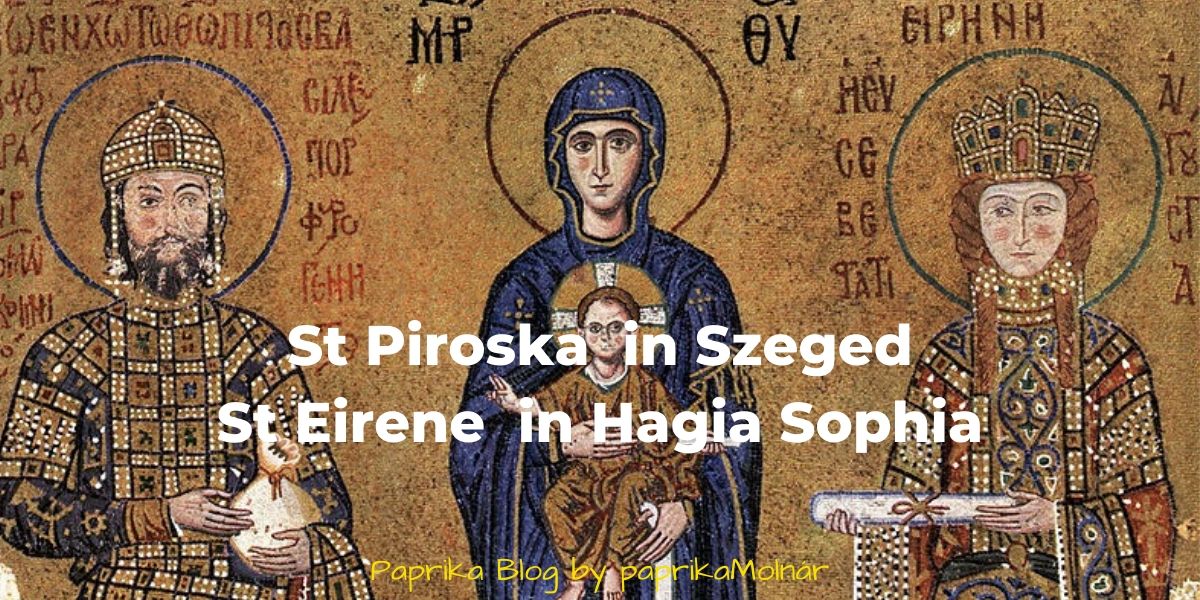January 18 is the name-day of Piroska in the Hungarian calendar. No longer a popular name today but a hundred years ago Piroska was a common name given to newborn girls. Who was Piroska?
Saint Piroska plays an important role both in Hungarian history and Szeged local history. In 1921 the people of Szeged Lower Town chose St Piroska as Protector of the new bell that they ordered for their old church. The new bell became known as the Paprika Bell, a masterpiece that figures St Piroska and paprika plants as decoration.
Saint Piroska, the Byzantine Empress Eiréné
According to the biography available to us, Piroska was the daughter of Hungarian King Saint Ladislaus I. In 1104 she was married to John II Komnenos, the heir to the Byzantine Empire. With the marriage the king hoped to ensure peaceful co-operation between Hungary and the Byzantine Empire in Constantinapole.
When Piroska became a Byzantine Empress, she switched homes, name and church. She became known as Eiréné in Constantinapole and converted from Roman to the Eastern Orthodox Church. Yet, she does not belong to eastern Christianity only: she’s remembered fondly from east to west as founder of monasteries, patron saint of the poor and the embodiment of a kindly queen. She’s recognized as a saint both east and west. Hungarian peasant families named their daughters in the hope of transferring the virtues – kindliness and peacefulness – she represented.
There are two fascinating examples of the love and respect that people have felt towards Eiréné or Piroska: the world-famous mosaic figure of Eiréné on the walls of Hagia Sofia and Saint Piroska figuring on the beautiful Paprika Bell in Szeged.
Saint Piroska and the Paprika Bell
On 28 May 1921 Szeged people had good reason to celebrate: Szeged Lower Town people bought four new bells for their church. The biggest of the bells was called Paprika Bell because the people who had raised money for the bells were all paprika processing people. They had the bell decorated with paprika fruits and plants and chose as Protector their beloved Saint Piroska!
This is how the local daily newspaper wrote about the day of the dedication:
“To replace the bells that were used for war purposes, the Catholic societies of Szeged started fund raising. Szeged Lower Town was first to succeed. The rich people of the suburb quickly gathered the amount needed for the bells. As a result, four church bells were ordered and they duly arrived yesterday at the Tisza Railway Station. The bells were welcomed with a grand and spirit-lifting ceremony…
At 3 pm a large crowd was gathering in Mátyás Square in front of the church. At 3.15 the crowd started quietly marching in regular rows of eight towards the train station. The four new bells were lifted from the train wagons, loaded onto beautifully decorated horsecarts and driven to the church. The crowd returned to the church with cheers and a military band playing. The church choir closed the ceremony.
The celebration will continue on Saturday when the new church bells will be consecrated and placed in their final place in the tower. From then on the new bells will invite worshippers to pray to God and celebrate Hungarian resurrection.”
The arrival of the church bells and the dedication ceremony must have had a tremendous meaning for the people of Szeged. The War Treaty signed in Trianon palace had just been a fresh memory. It drew the border just south of Szeged, tearing families apart, tearing people and lands away from Szeged. The pain and loss was fresh and people wanted to celebrate.
In our next week’s post we will write about the decoration and dedication of the Paprika Bell.
Tetszett a cikk? Ha szeretne még paprikás és fűszeres témában, heti rendszerességgel cikket olvasni, hírt kapni az ÚJ paprika elkészültéről, iratkozzon fel hírlevelünkre. Subscribe to our Blog and enjoy our Paprika Poster.







